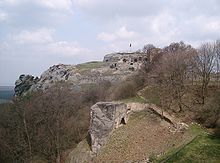- County of Regenstein
-
This article is about the county. For its ruling family, see House of Regenstein. For the castle, see Regenstein Castle.
County of Regenstein
Grafschaft RegensteinState of the Holy Roman Empire ← 
1160–1599  →
→Coat of arms
Capital Derenburg Government Principality Historical era Middle Ages - Partitioned from
County of Blankenburg
1160 1160- County of
Regenstein-Heimburg
1366- Personal union
with Blankenburg
1368- Joined
Lower Saxon Circle1500 - Fell to
Bishopric of Halberstadt
1599 1599- Acquired by
Brandenburg-Prussia1648 The County of Regenstein was a mediæval statelet of the Holy Roman Empire.
The counts of Regenstein Castle near Heimburg were first mentioned in a 1169 deed, with Count Conrad of Regenstein, son of Poppo I, Count of Blankenburg (1095–1164), himself a nephew of Count Reinhard, Bishop of Halberstadt from the Ripuarian House of Reginbodo[1].
The most renowned Count of Regenstein was Albert II (1310–49)[2], who in the 1330s was frequently in dispute with the leaders of the surrounding estates like the Halberstadt bishops and the abbess of Quedlinburg. These tales were romanticised in the ballad The Robber Count (German: Der Raubgraf) by Gottfried August Bürger, melodized by Johann Philipp Kirnberger and the novel of the same name by Julius Wolff[3].
In the 15th century the comital family relocated its seat to Blankenburg; Regenstein Castle lapsed and was left to ruin. The last scion of the comital family, Count John Ernest, died in 1599. With Blankenburg it fell back to the Bishopric of Halberstadt. Shortly thereafter Blankenburg and Regenstein were separated. Regenstein remained with Halberstadt, while Blankenburg was annexed and held by the Dukes of Brunswick-Wolfenbüttel.
Contents
Counts of Regenstein
- Siegfried (-1073), brother of Konrad, Count of Blankenburg-Regenstein
- Henry (-1235), son
- Siegfried II (-1251), son
- Ulric, Count of Regenstein-Heimburg (-1267), brother
- Ulric III (1287–1322)
- Albert II (1310–1349), son
- Albert III (1341–1365), son
- John Ernest, Count of Blankenburg and Regenstein (-1599)
Notes
The following articles do not yet exist on the English Wikipedia, but do exist on the German Wikipedia:
- ^ Reginbodonen (German)
- ^ Albrecht II. von Regenstein (German)
- ^ Julius Wolff (German)
External links
References
- This article incorporates information from the German Wikipedia.
 Lower Saxon Circle (1500–1806) of the Holy Roman Empire
Lower Saxon Circle (1500–1806) of the Holy Roman EmpireEcclesiastical 
Secular Bremen (from 1648) · Brunswick (Blankenburg (until 1731) · Calenberg2 · Grubenhagen (until 1596) · Wolfenbüttel) · Hanover (from 1708) · Holstein (Glückstadt · Gottorp) · Lüneburg2 · Mecklenburg (Güstrow (until 1695) · Schwerin · Strelitz (from 1701)) · Rantzau (until 1734) · Regenstein · Saxe-Lauenburg2Cities 1 until 1648. 2 until 1705. Coordinates: 51°48′54″N 10°57′36″E / 51.815°N 10.960°E
Categories:- Former principalities
- Former countries in Europe
- States of the Holy Roman Empire
- States and territories established in 1160
- States and territories disestablished in 1599
- 1599 disestablishments
- Lower Saxon Circle
- States and territories established in 1368
- Saxony-Anhalt geography stubs
- German history stubs
- German nobility stubs
Wikimedia Foundation. 2010.


